Physical Address
304 North Cardinal St.
Dorchester Center, MA 02124
Acknowledgment: The authors would like to thank and acknowledge the work of Dr. Karen Johnson Jones in previous versions of this chapter
.
Treatment of peripheral nerve compression in the upper extremity is one of the main components of a hand surgeon’s practice; however, most shy away from treatment of thoracic outlet syndrome (TOS). Objective electrodiagnostic studies of carpal tunnel, cubital tunnel, and other compressive neuropathies can confirm or refute clinical suspicions, or determine the stage of disease, and provide support for treatment. Because TOS is a compressive neuropathy that may include all of the nerves to the upper extremity, neck, shoulder, upper back, and chest, it may share the characteristics of or mimic the other compressive neuropathies. For most surgeons who do not regularly operate on the upper extremity, and for many who do, there are few disorders as difficult to diagnose or as frustrating to treat as TOS. Diagnosis is by exclusion and suspicion and is often based on clinical criteria alone because there is no definitive electrodiagnostic or imaging test that can verify the surgeon’s opinion. Most TOS patients have seen an average of 4.7 doctors before a diagnosis is established.
Although hand surgeons see many patients with vague upper-extremity pain, few have received training in recognition and treatment of TOS. In major texts that describe TOS, there are no chapters by hand surgeons. Because the area of compression lies in “expensive real estate,” even fewer treat TOS surgically, and still fewer operate without collaborating with a vascular or thoracic surgeon. In an email survey of the American Society for Surgery of the Hand (ASSH) membership regarding TOS, 60% of respondents reported that they treat TOS patients, but only 19% perform surgery for TOS, and only 10 of the 255 hand surgeons who responded treat more than 10 cases per year. A third of respondents operate with a vascular or thoracic surgeon present; this may be appropriate because the typical fellowship-trained hand surgeon may not be prepared to handle the potential risks. Interestingly, almost 20% of the respondents did not believe TOS exists as a legitimate diagnosis.
Historically significant events in the early recognition of TOS as a clinical entity are detailed in the text by Sanders and Haug, Thoracic Outlet Syndrome: A Common Sequela of Neck Injuries. These authors note three important historical periods, and the reader is referred to that text for a comprehensive discussion of the individual historical events. A second excellent source of historical information and state-of-the-art treatment is available as a monograph published as an edition of Hand Clinics.
The two basic types of TOS are vascular and neurogenic. The vascular type is further divided into arterial and venous subtypes, and the neurogenic type has been subdivided into “true” and “disputed” neurogenic. The subclassification and distinction of true versus disputed neurogenic TOS are attributed to Wilbourn.
Patients with the arterial, venous, and electrically positive neurogenic TOS present with an obvious mechanical obstruction to blood flow or have positive electrodiagnostic tests and rarely have secondary concerns (e.g., workers’ compensation issues, litigation) that cloud the issue. Diagnosis by physical examination, routine diagnostic imaging, or testing for neurogenic TOS is straightforward, and surgical treatment, when indicated, is relatively successful.
The fourth subtype (i.e., disputed neurogenic), however, has been more difficult for some physicians to accept. Although the classification was described first in 1984, it is time to drop this nomenclature and adopt the term electrically negative neurogenic TOS. This is because patients with it account for up to 97% of all those diagnosed and treated for TOS. It is only a disputed entity for those clinicians who require findings on objective diagnostic studies or imaging for verification of clinical findings. So far there have been no definitive studies by which one can make the diagnosis; therein lies the problem.
Arterial TOS is uncommon, accounting for only 1% to 2% of all cases of TOS. There is almost always an osseous anomaly such as a cervical rib, an anomalous first rib, or a history of fracture ( Fig. 29.1 ). Arterial TOS may present as a limb-threatening condition. The subclavian artery can become stenotic or develop an aneurysm because of compression between the rib and the clavicle or because of traction over the cervical rib. In addition, it can ulcerate, become occluded, or become thrombotic. , There can be fingertip ulcerations, Raynaud’s symptoms, pain, and claudication. The arterial type is more commonly indolent and has a history that suggests intermittent complete or partial arterial occlusion. Symptoms may be brought on by sports activities that place the upper extremity in an extended and hyperabducted position. Clavicle nonunion, malunion, posttraumatic subluxation of the sternoclavicular joint, and rib fractures also have been identified as causes. It is unlikely to have a case of arterial TOS without a bony anomaly.
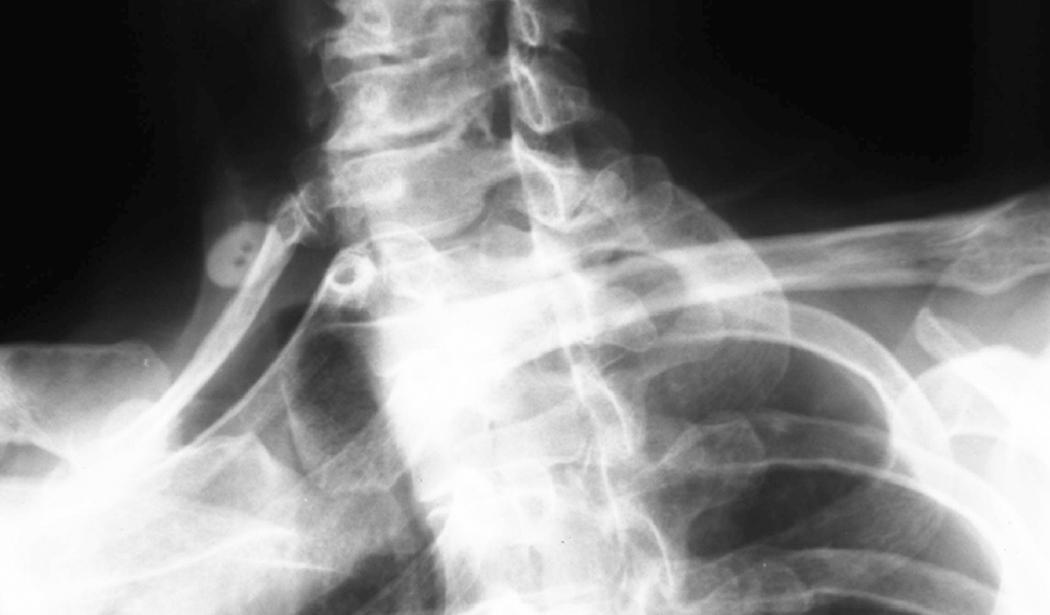
Venous TOS is slightly more common than the arterial type and represents 2% to 3% of all cases. These patients may have a sudden, effort-induced thrombosis (i.e., Paget-Schroetter syndrome) or, less commonly, a thrombosis that occurs at rest with the extremity in a compromised position for a prolonged time. There may be intermittent venous compression alone or intermittent compression that precedes a sudden event. With time, large venous collaterals around the shoulder, chest, or breast may develop ( Fig. 29.2 ).
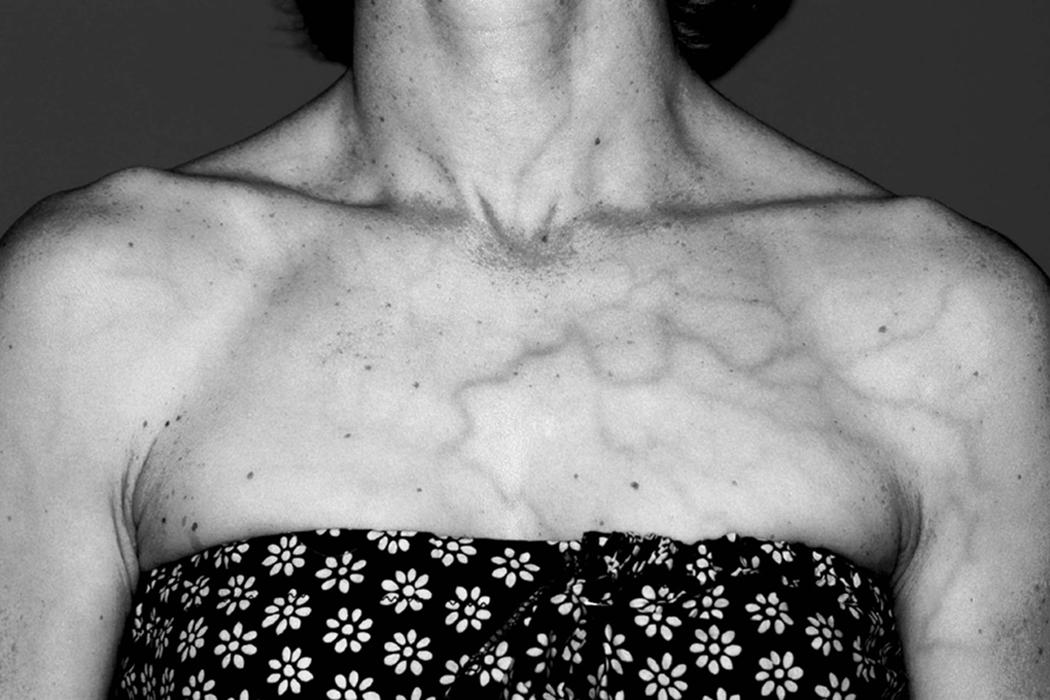
In acute thrombosis, pain, edema, and cyanosis are dramatic. In contrast, in patients who have a history of intermittent compression, collateral venous drainage minimizes the signs of distal swelling and cyanosis. In the intermittent compression group, however, fullness in the supraclavicular and infraclavicular areas may make the clavicle difficult to discern. Most acute venous TOS is seen in muscular young males with symptoms that develop after vigorous exercise or physical exertion. Throwing athletes and swimmers have been recognized as “at risk” owing to repetitive extremity positioning in postures that occlude the subclavian vein. Hypercoagulable states put these people at risk as well.
“True” or electrically positive neurogenic TOS is also rare, estimated to occur in 1 out of 1 million patients with TOS. These patients have objective physical evidence of chronic nerve compression (e.g., hypothenar atrophy, decreased grip, and sensory deficits), usually in the C8-T1 distribution ( Fig. 29.3 ). The pain and paresthesias seen in the other subtypes also may occur. In true neurogenic TOS there may be a bony anomaly causing the compression, such as a rudimentary or fully developed cervical rib ( Figs. 29.4 and 29.5 ), although most patients I have seen with this just have compressive bands.
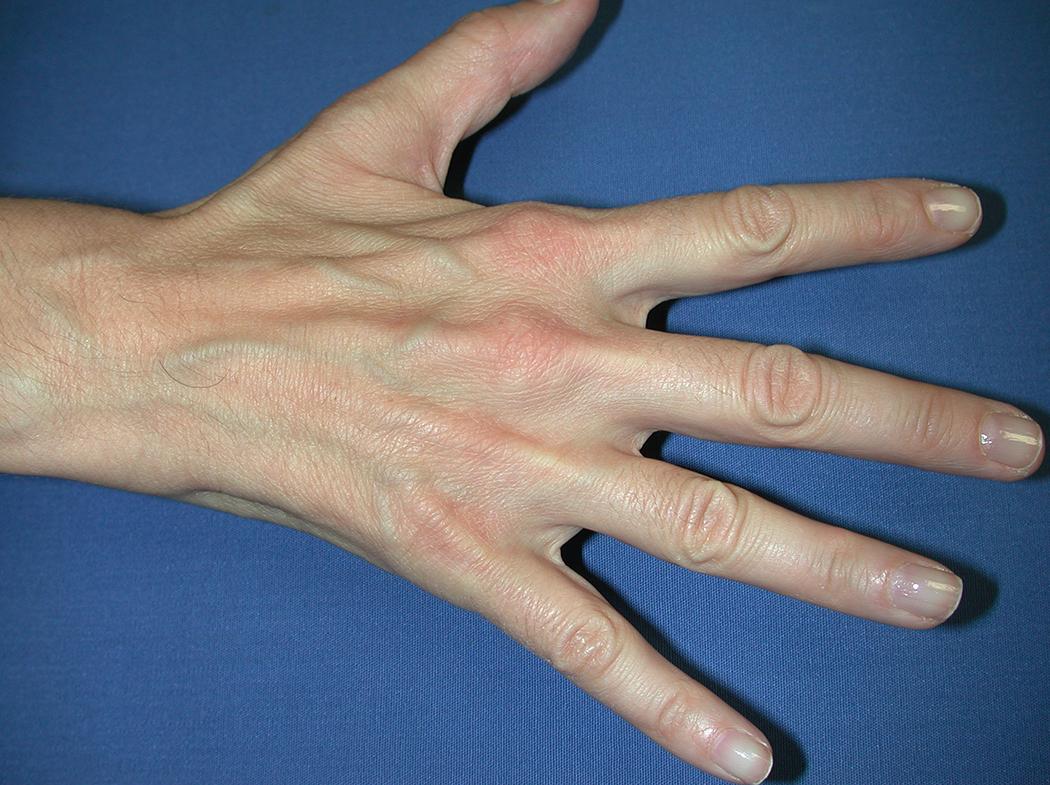
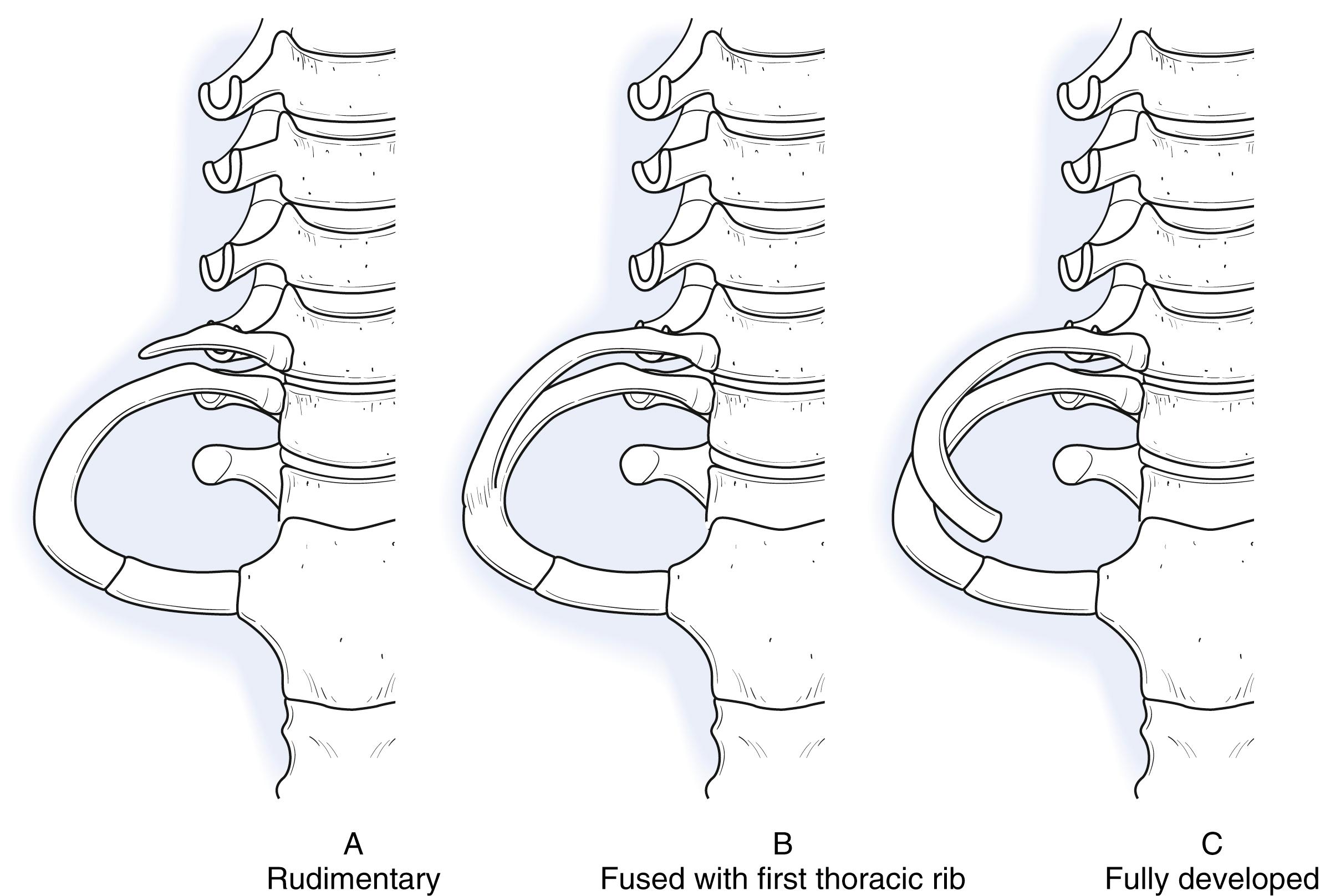
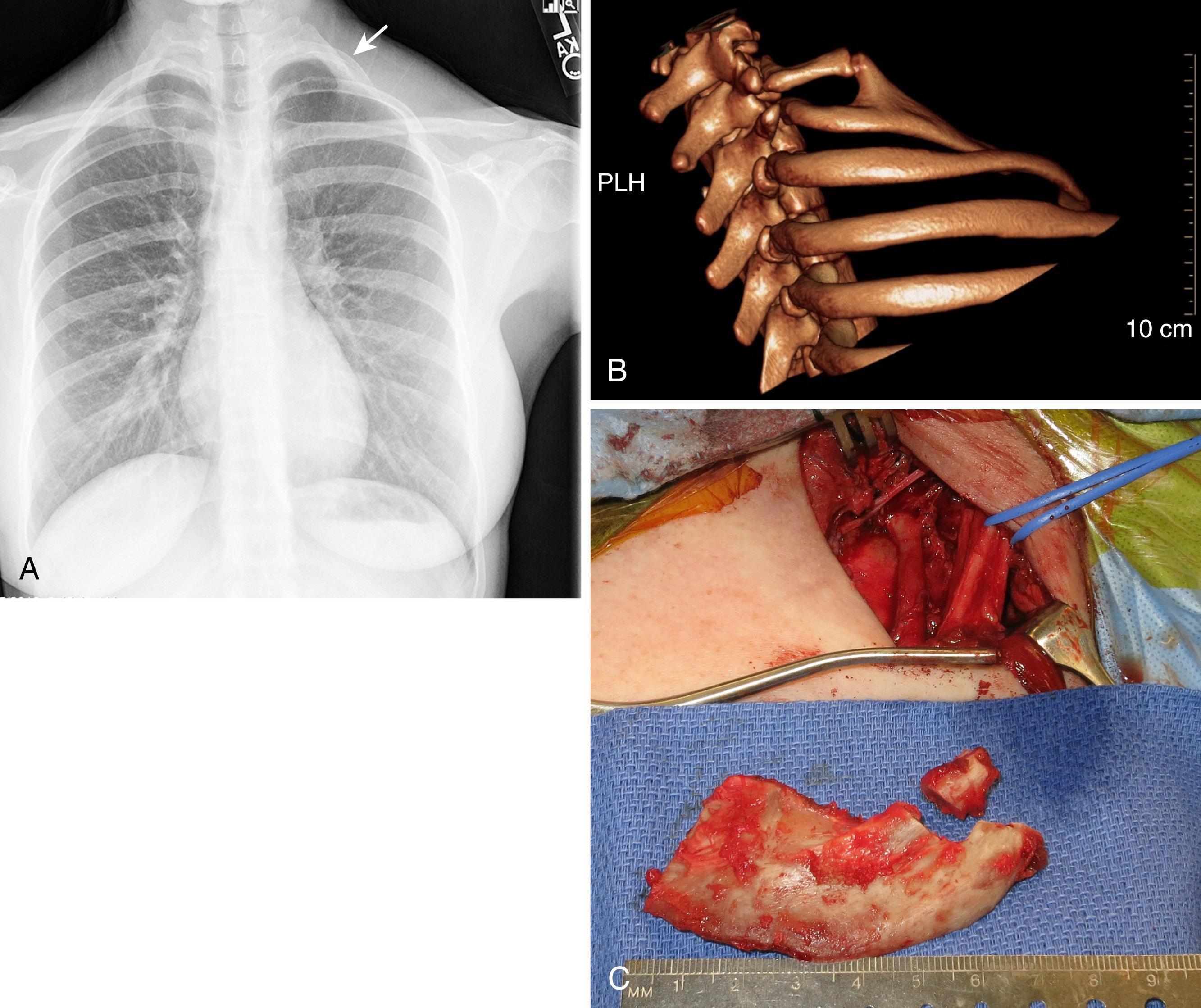
This type of TOS is by far the most commonly encountered (>95% of cases). These patients have a wide variety of upper extremity complaints, and usually no objective findings are found on electrodiagnostic testing, Doppler imaging, pulse volume recordings, or radiographs. Even though there may be some ambiguity of symptoms, most patients have numbness in the hand and pain in the arm, hand, and especially the shoulder and neck. Frequently there is activity-related or positional exacerbation. Most TOS surgeons would agree that physical complaints reproduced by provocative testing alone, in the absence of another explanation for the patient’s complaints, are sufficient to justify a working diagnosis of neurogenic TOS. In our practice, numbness in the ulnar nerve distribution of a patient with clinical symptoms consistent with TOS, but with negative electrodiagnostic studies, is indicative of TOS until proven otherwise.
In 1982, Roos classified TOS according to the segment of the brachial plexus involved. Categories of compression include upper trunk, lower trunk, and combined. Symptoms attributable to the lower- and combined-compression groups are found in 85% to 90% of all patients with TOS. Electrical studies are of no value for this classification scheme.
TOS is diagnosed in women 3.5 to 4 times as often as in men and most frequently in adults of working age. Occupational risk factors for TOS have been suggested. From 1987 to 1989, according to the Bureau of Labor Statistics, there was a 100% increase in the reported number of cases of cumulative trauma disorder (reporting requirements also changed dramatically during that time). Diagnoses reported in the shoulder region, including TOS, ranked second in frequency only to lower back and neck complaints. Awkward or static upper-extremity positioning, including holding the arm in 45 degrees of abduction, has been found to increase the prevalence of TOS symptoms. Hairdressers, painters, heavy-construction workers, grocery clerks, nurses, and clerical workers have more complaints of TOS symptoms compared with the general population. These occupations have in common repetitive lifting or repetitive, uninterrupted arm movements with the hand at or above the shoulder level and awkward or static extremity posture.
The reported incidence of TOS in the general population is 1% or 2%, and it may be this low because TOS is underdiagnosed and undertreated. , In my series of several hundred patients with TOS, 25% of them previously had shoulder surgery on the same side. Also, in the same group of patients with rotator cuff and shoulder injuries, a significant number had numbness and tingling, dysesthesias, and neurogenic symptoms at the time of initial presentation. The same forces that can cause a cuff or labral tear are certainly sufficient to cause an injury to the scalenes or brachial plexus.
Though TOS is often missed in the adult population, we are now seeing an increased number of adolescent TOS patients being diagnosed by both sports surgeons as well as primary care physicians. It is unknown if this increase is due to more cases from year-round, intense sports-related activities or if it represents an increase in awareness. These patients see on average two other health care providers before referral, with 20% of them having other previous surgical intervention before referral ( Case Study 29.1 ). FLOAT NOT FOUND
K.C. was first seen when she was 8 and complaining of pain with popping in her right, dominant shoulder, especially after playing tennis. Her exam showed mild discomfort when her subscapularis and infraspinatus were tested. Her plain films and magnetic resonance imaging (MRI) at that time were normal. She was told to rest. Her shoulder settled down to some degree, but she presented a year later after experiencing a painful pop while roughhousing. At this time she had a +3 sulcus sign and a positive apprehension test but normal strength. She was felt to have a degree of multidirectional instability (MDI) and was started on physical therapy, which did not help much. She continued to have pain and a few months later was noted to have increased only a +1 sulcus sign, increased translation in the autonomous plane (AP), and another MRI that was normal.
Subsequently, she improved to a small degree and 2 years later was seen again, this time with pain during volleyball and basketball games, having backed off tennis to a significant degree. She had excellent strength, normal motion, and only a trace sulcus sign and was felt to have scapular dyskinesis. K.C. was also having some arm and neck pain but cervical spine films were normal. She was started on home exercises and stretching and had some improvement and continued to play sports. Then while playing soccer, she was flipped over and landed on her head. She presented with neck pain that settled down in a few weeks with rest and returned to sports. However, a month later she began having neck, shoulder, and scapular pain; an MRI of her cervical spine was normal, so it was surmised that she was having myofascial pain. She continued to play tennis within the degree of discomfort that she could, did exercises intermittently, and continued to have shoulder and neck pain.
She then began to have periscapular pain without any new injury and continued shoulder pain. She noted that her exercises actually aggravated the pain. She was diagnosed with scapular bursitis and started on exercises for that; had another MRI, which was normal; then began to have numbness with overhead activity (e.g., doing her hair). She also had significant numbness in her thumb with some pain. The mother noted that they had exhausted physical therapy and had even seen another orthopedist who had recommended a scope with capsular reconstruction.
When I saw the patient, she was complaining of pain in her right shoulder, to a lesser extent in her neck, and numbness and tingling down the arm into her fingers. She had to give up sports activities because they made her worse; exercises also had made her worse, as did doing her hair. She did not have any cold intolerance.
A physical exam showed mild scapular asymmetry at rest but no winging with motion, which was full. She had a markedly positive Roos score, a markedly positive upper-limb tension test, tenderness in her anterior triangle and infraclavicular as well. K.C.’s pulse weakened during the Roos test but did not go away. There was no atrophy around the shoulder or hand. She was shown how to do scalene stretching at home and started on Neurontin; these afforded her no improvement, so she elected to have surgical intervention.
Surgery consisted of resection of anterior and middle scalene, complete neurolysis of the plexus to the neural foramen, excision of the coracocostal ligament, and examination of the infraclavicular plexus for possible pectoralis minor compression. She was found to have significant fibrosis of her posterior fat pad with scarring along both the suprascapular and long thoracic nerves. She also had a very thick pleura band compressing the lower trunk against the first rib, a coracocostal ligament pressing the plexus against the chest wall, but no impingement from the pectoralis minor.
The afternoon of surgery she was able to put her arm over her head easily without any numbness or tingling or change in pulse. At 7 months, she was playing tennis and other sports and only had minimal discomfort in her shoulder and occasional tightness in her chest. She did not have symptoms of shoulder instability. At 1 year, K.C. had some headaches and neck pain that was felt not to be related to her TOS; her exam at that time showed a negative Roos test, negative upper-limb tension, no anterior triangle or infraclavicular tenderness, and excellent motion and strength of her shoulder and arm. She is now almost 3 years postoperative and has qualified for a tennis scholarship and is playing on a regular basis with only an occasional ache if she does other sports activities. She can do her hair and other overhead activities without any difficulty.
The general anatomy of the thoracic outlet and brachial plexus is familiar to upper-extremity and vascular surgeons. However, the specific neuroanatomy of the brachial plexus, the vascular components of the thoracic outlet, and the bony and muscular anatomy are highly variable among patients. Fibrous or fascial bands, as well as developmental or acquired variations, are not uncommon, and movement or positioning of the neck, thorax, and shoulder girdle can cause dynamic compression against normal or anomalous structures (see Fig. 29.4 ). In one series of 200 consecutive transaxillary surgical approaches for TOS, cervical ribs were encountered in 8.5%, scalenus minimus in 10%, subclavius tendon anomalies in 19.5%, and anomalies of scalene muscle development or insertion in 43%. The limited exposure of the plexus afforded by the transaxillary approach may have obscured additional anomalies. In another study of 250 cadavers (i.e., 500 thoracic outlets), anatomic anomalies were noted in 46%. In another anatomic study where the brachial plexus was dissected in 65 cadavers, only 50% had the expected branching pattern of the superior, middle, and lower trunks traveling between the anterior and middle scalene muscles with the remainder exhibiting different variations of piercing the scalene muscles. In a study of 40 aborted fetuses, anomalies were found in 60%. ,
The anatomic corridor in the thoracic outlet has been partitioned into three sections: the interscalene triangle, the costoclavicular triangle, and the subcoracoid or pectoralis minor space ( Fig. 29.6 ).
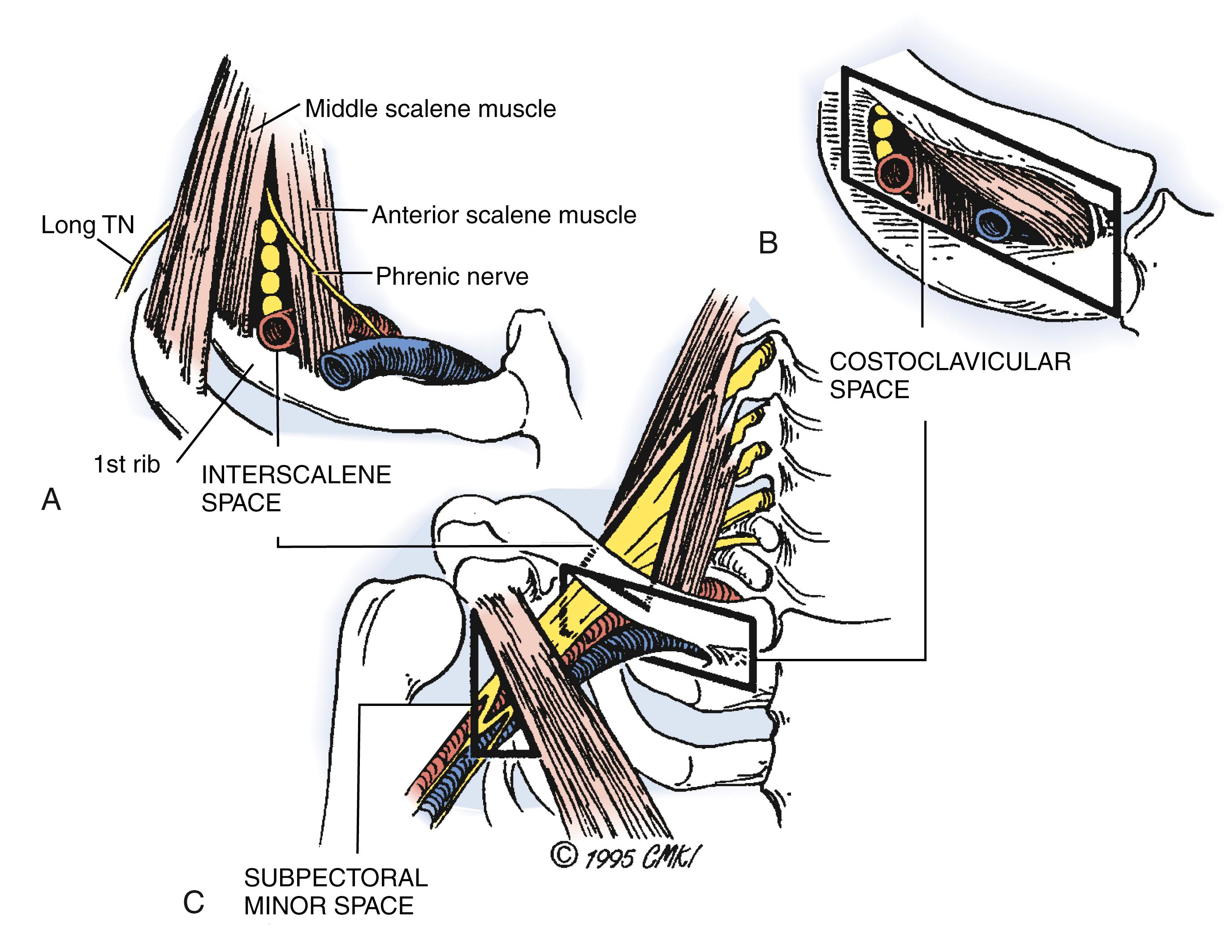
The interscalene triangle (the most common site for compression) is defined anteriorly by the anterior scalene muscle, posteriorly by the middle scalene muscle, and inferiorly by the first rib. The subclavian vein passes anterior to the anterior scalene and just inferior and lateral to the costocoracoid or costoclavicular ligament. The subclavian artery passes with the plexus between the anterior and middle scalenes. The anterior scalene originates from the anterior tubercles of the transverse processes of C3 to C6. The middle scalene originates from the posterior tubercles of the transverse processes of C2 to C7.
A wide range of anatomic variation can predispose to pathology. Actual crossing, or “intercostalization,” of the scalene insertions has been found in 15% of cadaver dissections. It is not uncommon to find slips of the middle scalene penetrating between the upper and middle, or middle and lower, trunks causing direct compression with every contracture. This also may produce a “V”-shaped deformity at the base that can have a scissoring effect on the neural and vascular structures. Alternatively, a “U”-shaped formation can create a sling effect that places pressure on the structures from below.
The scalenus minimus muscle comes up from C6 to C7 and inserts on the deep fascia between the subclavian artery and lower trunk, where it can produce a wedge effect on the lower trunk. It also may wrap around the subclavian artery and pull it against pleural bands, causing positional changes in flow. The downward slope of the first rib, when increased (more commonly seen in women), may drive the neurovascular structures into the angle formed by the lateral edge of the anterior scalene tendon and the first rib (see Fig. 29.6A ).
Cervical ribs, a commonly cited etiology for TOS, have been identified in 0.5 to 0.6% of the population and are bilateral in 50% to 80% of those affected. Because cervical rib growth is developmentally suppressed by a full contribution of the lower spinal nerve root (T1) to the plexus, there is an association between cervical ribs and a prefixed plexus. Many cervical ribs will be incomplete but have a taut fibrous band, or “anlagen,” connecting the bony tip to the first rib or deep fascia ( Fig. 29.7A ). Such a fibrous band represents only one of many types or locations of fibrous bands that cause nerve compression in TOS patients.
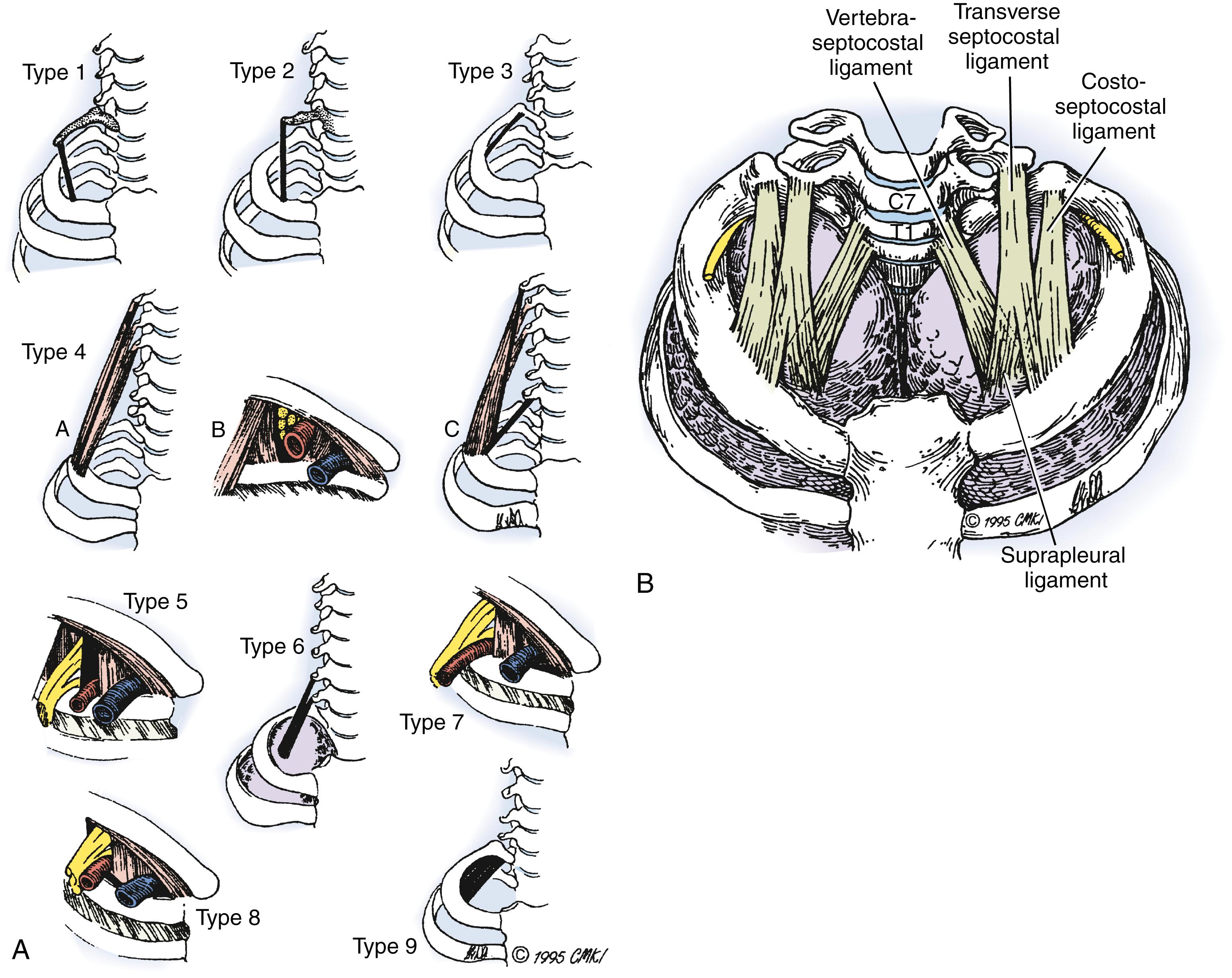
Roos described nine different patterns of fibrous bands seen in clinical and cadaveric specimens, and Poitevin reported three additional types of bands a decade later (see Fig. 29.7 ). The most frequently found bands were those seen to bowstring across the anterior concavity of the first rib, the “scalenus minimus” muscle band, and the fascial attachments between the anterior and middle scalene muscle groups, crossing the nerve roots of the brachial plexus in either an oblique or a perpendicular manner. In addition to these bands, compressive bands across the lower trunk, compression from Sibson’s fascia, and apical scaring of the pleura to the lower trunks have all been described ( Fig. 29.8 ). , ,

The costoclavicular space is bounded anteriorly by the clavicle, subclavius muscle, and costocoracoid ligament; posteromedially by the first rib; and posterolaterally by the superior border of the scapula (see Fig. 29.6 ). Physiologic narrowing of this space with limb movement is enhanced by the mobility of joints at both ends of the space’s boundaries. A hypertrophied subclavius tendon insertion can apply compression specifically to the subclavian vein, as in Paget-Schroetter syndrome. Although there is little in the literature regarding the costocoracoid ligament, it can occasionally be much larger than the coracoacromial ligament and may firmly compress the plexus against the chest wall.
The subcoracoid space allows compression via three mechanisms. With arm abduction, the neurovascular bundle stretches around the coracoid, and external rotation of the scapula accentuates this pulley effect. Abduction also tenses the pectoralis minor tendon and, in some instances, the tendon and/or muscle belly may compress the plexus. Compression here may occur in isolation in 6% to 30%, or in combination with other areas of compression in 22% to 75% of TOS cases.
Become a Clinical Tree membership for Full access and enjoy Unlimited articles
If you are a member. Log in here